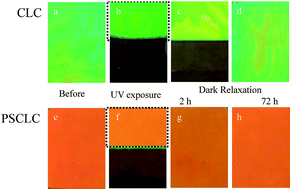Polymer stabilization of phototunable cholesteric liquid crystals
Abstract
Prior examinations of

- This article is part of the themed collection: Soft Matter Lectureship Winners
* Corresponding authors
a
Air Force Research Laboratory, Materials and Manufacturing Directorate, Wright Patterson Air Force Base, OH, USA
E-mail:
timothy.white2@wpafb.af.mil, timothy.bunning@wpafb.af.mil
Fax: +1 937 255 1128
Tel: +1 937 255 9551
b SOCHE, Dayton, OH, USA
c SAIC, Dayton, OH, USA
d BEAM Engineering for Advanced Measurements, 809 S. Orlando Ste. 1, Winter Park, FL, USA
Prior examinations of

 Please wait while we load your content...
Something went wrong. Try again?
Please wait while we load your content...
Something went wrong. Try again?
T. J. White, R. L. Bricker, L. V. Natarajan, S. V. Serak, N. V. Tabiryan and T. J. Bunning, Soft Matter, 2009, 5, 3623 DOI: 10.1039/B906758B
To request permission to reproduce material from this article, please go to the Copyright Clearance Center request page.
If you are an author contributing to an RSC publication, you do not need to request permission provided correct acknowledgement is given.
If you are the author of this article, you do not need to request permission to reproduce figures and diagrams provided correct acknowledgement is given. If you want to reproduce the whole article in a third-party publication (excluding your thesis/dissertation for which permission is not required) please go to the Copyright Clearance Center request page.
Read more about how to correctly acknowledge RSC content.
 Fetching data from CrossRef.
Fetching data from CrossRef.
This may take some time to load.
Loading related content
